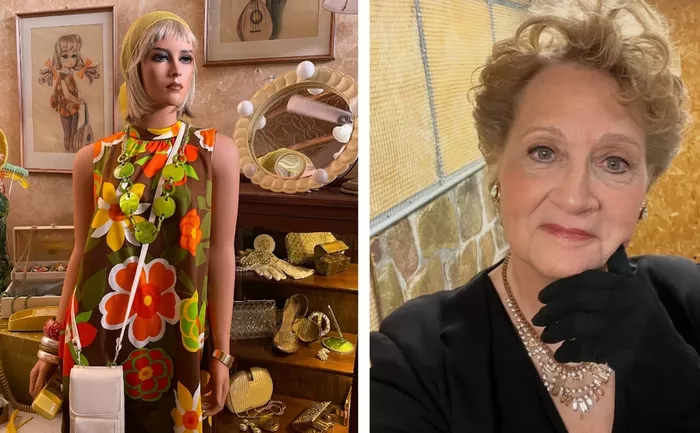Leslie Drollinger Stratmoen of Riverton has turned her lifelong love for vintage fashion into a remarkable historical exhibit. After years of searching flea markets, garage sales, and antique shops for unique and elegant women’s clothing, Stratmoen amassed a collection of thousands of garments and accessories. Over 3,000 of these items are now part of a major display titled Flappers to Fringe at the Occidental Hotel Museum in Buffalo, Wyoming. The exhibit spans from the 1920s to the 1970s and highlights how events, people, and places shaped women’s fashion through the decades.
According to Stratmoen, the exhibit educates visitors on the reasons behind changing hemlines, silhouettes, and style trends. It also honors the bold women who pushed fashion boundaries and paved the way for modern freedom of expression. Stratmoen’s fascination with vintage began when she started collecting jewelry in junior high, drawn to the beauty and affordability of costume pieces. In college, she began collecting clothing, finding it a stylish and cost-effective way to stand out.
Her passion grew alongside a career in journalism, during which she also performed with big bands and worked in theater, often designing costumes for plays and musical productions. Over the years, Stratmoen preserved these garments, driven by their craftsmanship and historical value. From musicals like Guys and Dolls to her work at Central Wyoming College, her collection expanded through both creative projects and opportunities to acquire pieces as costume warehouses downsized.
About a decade ago, Stratmoen considered turning her extensive wardrobe into an exhibit. Inspired by past displays like Windows of Time Through a Woman’s Eyes, she envisioned a traveling trunk exhibit reflecting women’s fashion journeys. Eventually, the concept grew into a broader historical showcase, focusing on the transformation of fashion between two pivotal periods — the 1920s and the 1970s. Both eras followed wartime and ushered in newfound freedom and self-expression for women.
The COVID-19 pandemic nearly halted her plans, but a visit from longtime friend Oakley Boycott, a model and actress from New York, rekindled her enthusiasm. Boycott had once assisted Stratmoen in a costume production as a teen. When modeling vintage outfits for documentation, she proposed building an online exhibit and helped Stratmoen bring her project back to life. They spent the lockdown period working on the presentation, reigniting the vision for Flappers to Fringe.
The idea became reality when the Stratmoens visited the Occidental Hotel in Buffalo during Thanksgiving. Co-owner Jackie Stewart, already familiar with the project, invited Stratmoen to host the exhibit there. With the help of a Spark Grant from the Wyoming Humanities Council, the massive collection was transported in April using the largest U-Haul available. It included nine full steamer trunks, 10 wardrobe boxes, hat boxes, stanchions, suitcases, racks, and staging furniture.
The exhibit, officially set up in April and fine-tuned in May, is arranged in six life-sized dioramas. Each scene features a mannequin representing a young woman from a specific decade, with her steamer trunk open and ready, surrounded by era-appropriate clothing, accessories, toiletries, and personal items. Stratmoen wanted to create immersive snapshots of what life might have felt like for fashionable women traveling through time.
Many of the pieces on display were found in Wyoming, and Stratmoen emphasized that fashion history here goes beyond cowboy hats. Flapper dresses and miniskirts worn by local women connect visitors with their heritage. These garments, unlike modern fast fashion, were made with care and built to last — a sentiment Stratmoen hopes visitors will appreciate.
The exhibit will remain on display for ten months, allowing Stratmoen to update it with seasonal flair. For the holidays, she plans to outfit the mannequins in festive attire and showcase her vintage fashion doll collection. She has no clear favorite item, noting that each piece evokes personal memories. The 1940s remind her of her mother, while the 1960s and ’70s recall her youth.
Visitors to the exhibit have already expressed emotional connections, sharing how certain pieces reminded them of grandparents or family photos. That nostalgic reaction is exactly what Stratmoen hoped to inspire — conversations about the past and deeper appreciation for those who lived it. She also wants younger women to recognize the trailblazing women of earlier generations who defied norms and helped shape modern style.
Stratmoen believes the exhibit will engage men, too, by showing how societal changes, like the invention of the car or wartime material restrictions, directly impacted women’s clothing. In the 1920s, for instance, cars made shorter, more mobile dresses necessary. In the 1940s, fabric rationing led to slimmer silhouettes, but designers got creative with sequins and rhinestones to add flair without using up precious textiles.
Even details like the popularity of peep-toe shoes reflect wartime limitations on leather. Stratmoen’s informational booklet accompanying the exhibit provides insights like these, drawn from her extensive research using vintage magazines, fashion books, and memoirs. One such memoir described how women in the 1920s used red tissue paper to tint their lips, a small but telling glimpse into the past.
Stratmoen has spent the last few weeks finalizing the signage and booklet that guides visitors through the exhibit. Her collection of historical fashion literature and magazines, like McCall’s, helped her present the clothing with accuracy and context. The result is an educational journey through fashion and social change across five dynamic decades.
The exhibit’s opening gala is scheduled for 7 p.m. on June 21 and is free to the public. Guests are encouraged to dress in vintage attire from any decade, adding to the spirit of celebration and style. Stratmoen sees Flappers to Fringe as just the beginning and is open to exploring other eras of 20th-century fashion in future exhibits, depending on public response and interest.
Related Topics

